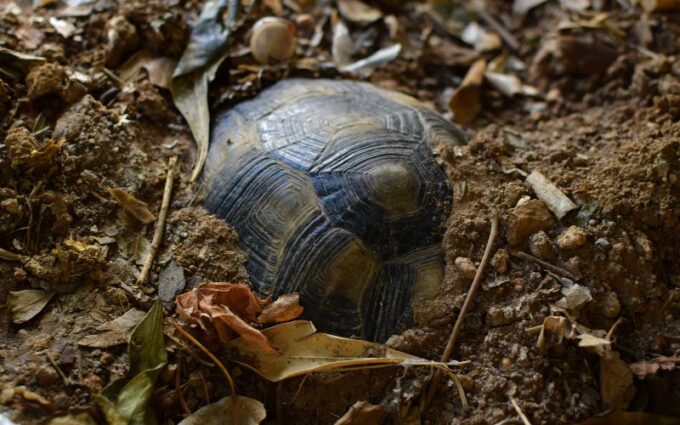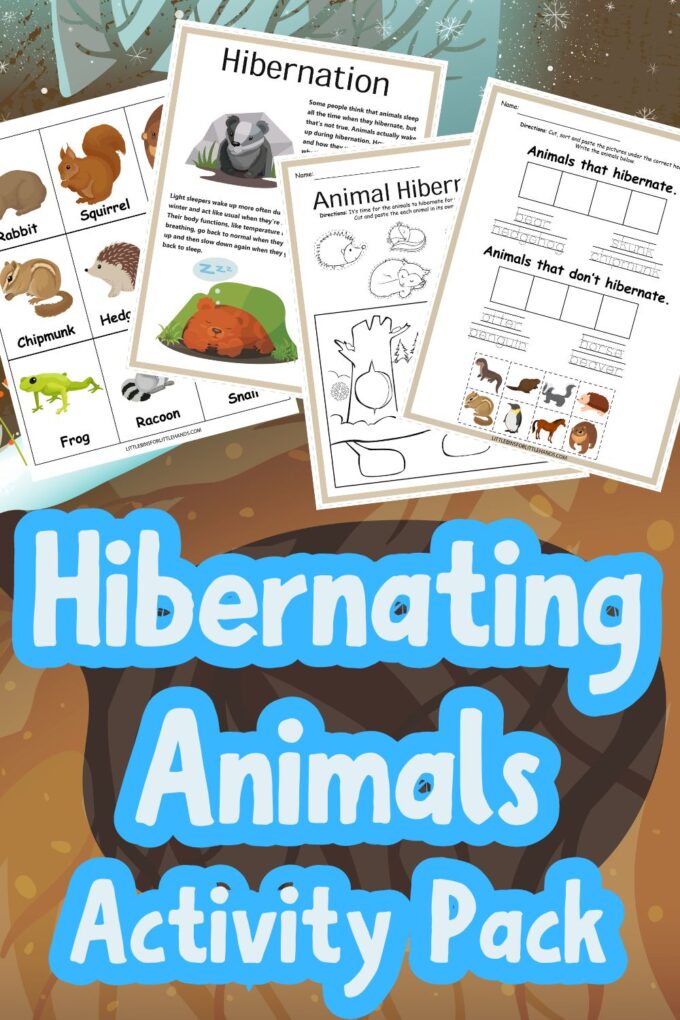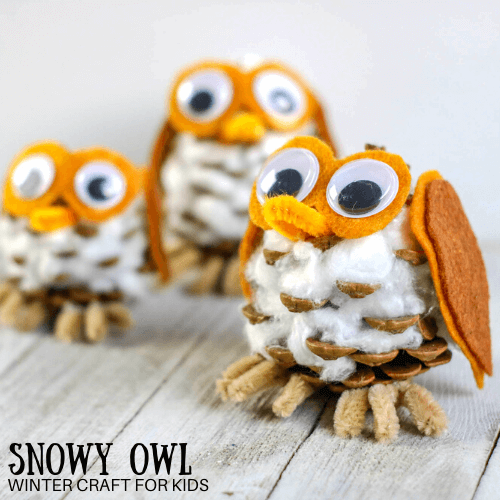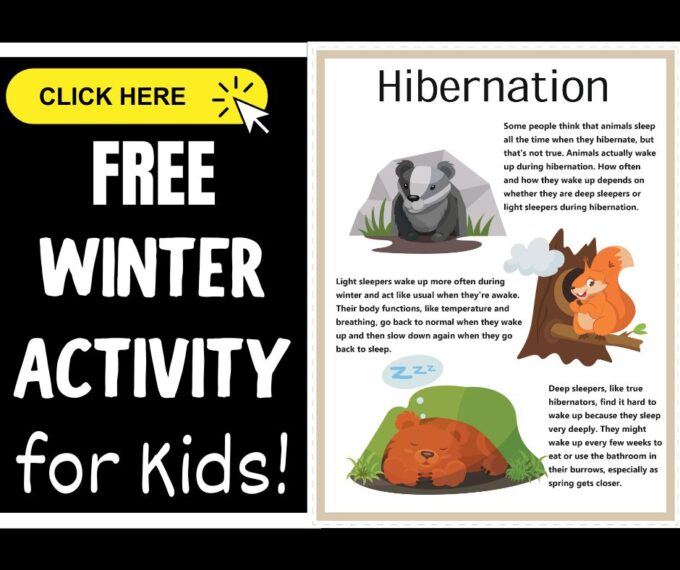This FREE printable hibernating animal pack is perfect for incorporating into winter lesson plans or winter activities! Kids can learn about all the different types of hibernating animals, where they hibernate during the winter, and other fun facts about animal hibernation!

Learn About Animal Hibernation
Learning about hibernating animals is a great way to introduce kids to an important adaption that some animals have to living in a very cold climate. Spark curiosity and encourage exploration of the natural world while exploring animal habitats.
Animal hibernation is a fascinating topic that can engage young minds and foster a love for learning about the environment and wildlife.
Suitable for preschool, kindergarten, and early elementary-age kids! Perfect for morning work, independent work, or as part of your winter science activities!
Young children in preschool and kindergarten to older children in 1-3rd grade will love these fun hibernating animal activity sheets!
Add them to your winter theme lesson plans. Share stories or facts about hibernating animals to make the concept relatable. Get small groups together and have them work on the worksheets together.
For younger kids, you can have them focus on basic concepts such as the different kinds of animals and cold weather. Have kids explore the world around them and teach them about why some animals hibernate during winter.
If you want to explore animal habitats more in depth, see our biome lapbook project and LEGO animal habitat cards.
What Are Hibernating Animals?
Hibernation is a fascinating part of nature where different animals, such as bears, polar bears, ground squirrels, and tree squirrels, take a long, deep sleep during the cold winter months.
These animals enter a state of true hibernation, where their heart rate drops and they develop a lower body temperature closer to the temperature of their surroundings. This helps them conserve energy and survive through the winter season.
It’s like a long nap but much deeper, and it’s a crucial part of their survival during harsh weather conditions mostly during the winter months.
Hibernating animals will often retreat to a sheltered location, such as a burrow, nest, or den, so they can remain relatively undisturbed.
To sustain themselves through the period of hibernation when food is scarce, animals rely on their stored fat reserves. These fat stores provide the necessary energy for survival.
Some hibernating animals can wake up for short times while they are hibernating. They can engage in activities such as eating, eliminating waste, and adjusting their position.
Different animals have different ways to hibernate. Some animals hibernate for the entire winter, while others may enter and leave hibernation multiple times or undergo a state of torpor without a fixed winter schedule.
NOTE: Torpor refers to a state of physical or mental inactivity. It is where an animal significantly lowers its metabolic rate, body temperature, and overall activity. But it is a temporary state and can be reversed! Some animals are not true hibernators because they will go in and out of torpor many times during the winter.
When do animals start hibernating?
The timing of hibernation varies based on factors such as the type of animal, its location, climate, and environmental conditions. Generally, animals hibernate when temperatures drop, and food availability is reduced.
For example; many hibernating animals, such as certain bears and rodents, typically begin their hibernation in the fall as temperatures drop.
Also learn why leaves change color in the fall with a lapbook.
When do animals stop hibernating?
Many animals that hibernate begin to wake up in the spring when temperatures rise. The increasing warmth is a signal for them to become active again.
Longer daylight hours in the spring also play a role in ending hibernation. The extended daylight cues animals to come out of their torpid state and start normal activity again. The end of hibernation is also timed with the increase of available food.
Free Hibernating Animal Pack
What’s included in this printable hibernating animal pack?
Add this hibernating animal pack to your winter lesson plans!
You will get the following worksheets:
- Hibernation Crossword (Wordsearch) Puzzle: Kids have to find all the hibernating animal names within a crossword puzzle.
- What Animals Hibernate During Winter?: Kids can circle the correct animal names that hibernate in winter.
- Animals That Hibernate vs. Animals That Don’t Hibernate Sorting: Kids can move pictures of animals to different categories, such as “Animals that hibernate” and “Animals that don’t hibernate.”
- Matching Sleeping Animals to Their Habitats: Some animals, like bears, hibernate in a bear cave, whereas others might hibernate in a nice, warm den. Smaller animals, like chipmunks, may hibernate in a tree trunk when it gets cold.
- Hibernation Facts: Kids can learn tons of fun facts about hibernation!
Note: While the skunk does not officially hibernate, it does go into a state of Torpor. They do many of the same things as hibernating animals, such as feeding heavily before the cold, preparing a den, and then taking a long nap until the warm weather arrives. However, they may wake up occasionally. Read more about the skunk here.
List of Hibernating Animals
Here are 10 animals that are known to hibernate:
1. Black Bear
Black bears are known to hibernate during the winter months. They enter a state of torpor, lowering their metabolic rate and living off stored fat.
2. Chipmunk
Chipmunks are small rodents that hibernate by entering a state of torpor in their burrows. They rely on stored food supplies for sustenance.
3. European Hedgehog
Hedgehogs hibernate during the winter, seeking shelter in nests or burrows. Their body temperature drops, and they enter a state of reduced activity.
4. Groundhog
Groundhogs, also known as woodchucks, are famous for their role in Groundhog Day. They hibernate in burrows during the winter, emerging in spring.
Celebrate Groundhog Day with these fun Groundhog Day Activities.
5. Bats
Many species of bats hibernate during the winter months in caves, mines, or other sheltered locations. Their metabolic rate decreases significantly.
6. Eastern Box Turtle
Eastern box turtles hibernate during the winter, seeking shelter in burrows or under leaf litter. They become less active as temperatures drop.
7. Wood Frog
Wood frogs are known for their ability to survive freezing temperatures. They hibernate in leaf litter or shallow burrows, with their bodies entering a partially frozen state.
8. Eastern Chipmunk
Similar to other chipmunk species, the Eastern chipmunk hibernates in burrows, relying on stored food for nourishment during the winter.
9. Common Snapping Turtle
Snapping turtles hibernate in mud at the bottom of ponds or other bodies of water. They can endure the cold conditions by slowing down their metabolism.
10. Fat-Tailed Dwarf Lemur
Found in Madagascar, the fat-tailed dwarf lemur hibernates during the dry winter months. It enters a state of torpor, relying on stored fat in its tail for energy.
Hibernation is a fantastic adaptation that allows these animals to survive winter’s challenges when food is scarce and harsh environmental conditions. Keep in mind that what hibernation looks like, and the length of time will vary among different animals and depend on factors such as climate and habitat.

More Fun Winter Activities
Learn about more adaptions animals have to live in the extreme cold with one of these winter activities below…
- Polar Bear Blubber Experiment
- Whale Blubber
- Reindeer Facts & Activities
- Penguin Activities
- Snowy Owl Craft



Printable Winter STEM Pack
Even if you don’t live in a snowy winter climate, there are many ways to explore the season!
WHAT’S INSIDE? You’ll find 250+ Pages of Winter theme projects for science, STEM, and art!
- 25+ Winter science activities and STEM projects for kids that are easy to set up and fit into the time you have available, even if it’s limited! NEW: Observation sheets for activities.
- Printable winter theme STEM activities that are simple but engaging for home or classroom. Perfect for K-2 and beyond and adaptable to many skill levels.
- Find simple background science explanations to share with kids while they explore hands-on and playful experiments, projects, and activities! Fun with physics, chemistry, design, engineering, and more!
- Easy to gather supplies makes these STEM activities ideal when you have limited resources available. Perfect for trying with groups of kids.
- Engaging winter STEM activities packed with winter theme activities, journal pages, and design process steps! Includes structure-building cards, STEM challenge cards, and screen-free coding activities.
- Fun snowflake theme STEM, including snowflake cutting templates, snowflake tinker cards, and snowflake science activities, including a snowflake formation cycle!
- Even more, winter printable sheets include hibernating animals sort, snow weather cycle, 5 senses for winter journal pages, thaumatrope patterns, and fun extras all with a winter theme!









